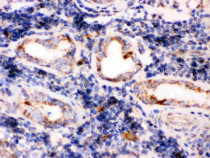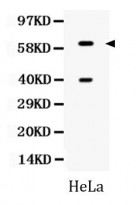ARG42649
anti-TPP1 antibody
anti-TPP1 antibody for IHC-Formalin-fixed paraffin-embedded sections,Western blot and Human
Overview
| Product Description | Rabbit Polyclonal antibody recognizes TPP1 |
|---|---|
| Tested Reactivity | Hu |
| Tested Application | IHC-P, WB |
| Host | Rabbit |
| Clonality | Polyclonal |
| Isotype | IgG |
| Target Name | TPP1 |
| Antigen Species | Human |
| Immunogen | Synthetic peptide corresponding to aa. 227-261 of Human TPP1. (CAQFLEQYFHDSDLAQFMRLFGGNFAHQASVARVV) |
| Conjugation | Un-conjugated |
| Alternate Names | EC 3.4.14.9; TPP-1; Tripeptidyl-peptidase I; GIG1; Lysosomal pepstatin-insensitive protease; SCAR7; Tripeptidyl aminopeptidase; Tripeptidyl-peptidase 1; CLN2; LPIC; Cell growth-inhibiting gene 1 protein; TPP-I |
Application Instructions
| Application Suggestion |
|
||||||
|---|---|---|---|---|---|---|---|
| Application Note | * The dilutions indicate recommended starting dilutions and the optimal dilutions or concentrations should be determined by the scientist. | ||||||
| Positive Control | HeLa | ||||||
| Observed Size | ~ 61 kDa |
Properties
| Form | Liquid |
|---|---|
| Purification | Affinity purification with immunogen. |
| Buffer | 0.2% Na2HPO4, 0.9% NaCl, 0.05% Sodium azide and 5% BSA. |
| Preservative | 0.05% Sodium azide |
| Stabilizer | 5% BSA |
| Concentration | 0.5 mg/ml |
| Storage Instruction | For continuous use, store undiluted antibody at 2-8°C for up to a week. For long-term storage, aliquot and store at -20°C or below. Storage in frost free freezers is not recommended. Avoid repeated freeze/thaw cycles. Suggest spin the vial prior to opening. The antibody solution should be gently mixed before use. |
| Note | For laboratory research only, not for drug, diagnostic or other use. |
Bioinformation
| Database Links | |
|---|---|
| Gene Symbol | TPP1 |
| Gene Full Name | tripeptidyl peptidase I |
| Background | This gene encodes a member of the sedolisin family of serine proteases. The protease functions in the lysosome to cleave N-terminal tripeptides from substrates, and has weaker endopeptidase activity. It is synthesized as a catalytically-inactive enzyme which is activated and auto-proteolyzed upon acidification. Mutations in this gene result in late-infantile neuronal ceroid lipofuscinosis, which is associated with the failure to degrade specific neuropeptides and a subunit of ATP synthase in the lysosome. [provided by RefSeq, Jul 2008] |
| Function | Lysosomal serine protease with tripeptidyl-peptidase I activity (PubMed:11054422, PubMed:19038966, PubMed:19038967). May act as a non-specific lysosomal peptidase which generates tripeptides from the breakdown products produced by lysosomal proteinases (PubMed:11054422, PubMed:19038966, PubMed:19038967). Requires substrates with an unsubstituted N-terminus (PubMed:19038966). [UniProt] |
| Cellular Localization | Lysosome. Melanosome. Note=Identified by mass spectrometry in melanosome fractions from stage I to stage IV. [UniProt] |
| Calculated MW | 61 kDa |
| PTM | Activated by autocatalytic proteolytical processing upon acidification. N-glycosylation is required for processing and activity. [UniProt] |
Images (2) Click the Picture to Zoom In
-
ARG42649 anti-TPP1 antibody IHC-P image
Immunohistochemistry: Paraffin-embedded Human lung cancer tissue stained with ARG42649 anti-TPP1 antibody at 1 µg/ml dilution.
-
ARG42649 anti-TPP1 antibody WB image
Western blot: HeLa whole cell lysate stained with ARG42649 anti-TPP1 antibody at 0.5 µg/ml dilution.







